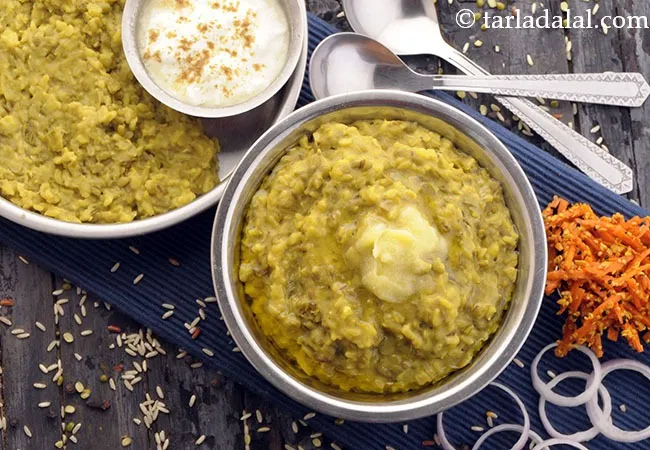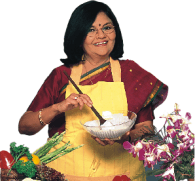Nutritional Facts of rice porridge recipe | pressure cooker rice porridge | Indian rice porridge for diarrhoea | Calories in rice porridge recipe | pressure cooker rice porridge | Indian rice porridge for diarrhoea |
This calorie page has been viewed 87500 times

Table of Content
How many calories does one cup of Rice Porridge have?
One cup of Rice Porridge gives 78 calories. Out of which carbohydrates comprise 62 calories, proteins account for 6 calories and remaining calories come from fat which is 10 calories. One cup of Rice Porridge provides about 4 percent of the total daily calorie requirement of a standard adult diet of 2,000 calories.
Click here to view. Rice Porridge Recipe | pressure cooker rice porridge | quick Indian rice porridge | with amazing 10 images.
Upset tummy or sick with diarrhoea? We have got a perfect recipe which is super light on tummy and can be digested easily “rice porridge”. You can even cook quick Indian rice porridge when you are having a long and tiring day as this recipe uses minimum of ingredients and is super quick to make.
To make rice porridge, heat the ghee in a pressure cooker and add the cumin seeds. When the seeds crackle, add the rice, salt and 3 cups of water, mix well and pressure cook for 5 whistles. Allow the steam to escape before opening the lid. Whisk the mixture well and cook on a slow flame for 5 to 7 minutes or till a thick consistency is obtained. Serve pressure cooker rice porridge immediately
Light on the stomach and comforting to the taste buds, this Rice Porridge, mildly-flavoured with cumin seeds, is ideal when you are feeling tired or unwell. It helps soothe your senses and top up your energy levels, slowly bringing you back to normal.
When the rice is cooked till soft, rice porridge is easy to digest and quickly gives a lot of energy, which is very important for those with diarrhoea. Although we usually avoid ghee when the stomach is upset, a wee bit – as used in this rice porridge recipe – is okay as it gives a soothing flavour and a little more energy too.
Cumin seeds too is a magic ingredient as far as this home remedy is concerned, because it gives a comforting flavour and also helps set the tummy right!
Is Rice Porridge healthy?
Yes, this is healthy. But restrictions apply to some.
Let's understand the Ingredients.
What's good.
1. Rice : Here are the pros for rice. Rice is a great source of complex carbohydrates, which is an important source of energy for our body. Rice is low in fibre and therefore a good option for people suffering from diarrhoea. What's not good in rice. Foods like rice are high in Glycemic index are not suitable for weight loss, heart patients, diabetics as they affect the blood sugar control levels. See details of is white rice and parboiled rice good for you?
What's not good in rice. Foods like rice are high in Glycemic index are not suitable for weight loss, heart patients, diabetics as they affect the blood sugar control levels. However if rice is combined with high protein or high fibre foods, the glycemic load can be balanced. Thus its combo is a better choice as we have done in the recipe of panch dhan khichdi and toovar dal khichdi. See details of is white rice and parboiled rice good for you?
2. Ghee : Other than calories and fats, the only nutrients that ghee is rich in are the vitamins – all of which are fat-soluble. All the 3 vitamins (Vitamin A, Vitamin E and Vitamin K) are antioxidants which have a role in removing free radicals from the body and protecting our cell as well as help in maintaining skin health and glow. Ghee is an excellent, high-quality selection medium of cooking because of its high smoke point. As compared to most oils and butter, ghee can handle a smoke point of 230°C, 450°F, thus its less prone to oxidant and destruction of nutrients. Yes, ghee does contain cholesterol, but some amount of cholesterol is needed by the body. Cholesterol has some functions to play too. It is necessary for hormone production, brain function, cell health and lubricating the joints. It is, in reality, a high quality fat for the body and brain. Ghee is loaded with fats but that’s medium chain fatty acids (MCT) which aid in weight loss. Ghee is healthy for daibetics in small amounts. Learn to easily make your ghee at home which is free of preservatives. See benefits of ghee.
3. Benefits of Cumin Seeds ( jeera) : The most common benefit of jeera known to many is to soothe the stomach, intestine and the entire digestive tract. Cumin seeds are apparently a very good source of iron. A tbsp. of cumin seeds can fulfil nearly 20% of days iron requirement. Even small quantity of cumin seeds has huge amounts of calcium ( see calcium rich Indian foods ) – a bone supporting mineral. They aid is digestion, weight loss and help reduce inflammation. See detailed benefits of cumin seeds, jeera.
Note : 1 cup = 200 ml (standard cup available in the market). The weight in grams varies for each ingredient.
Can diabetics, heart patients and over weight individuals have Rice Porridge?
Let's analyze the suitability of this Rice Porridge recipe for individuals with diabetes, heart conditions, and those managing weight.
For Diabetics
Rice (Chawal), particularly white rice, is the primary ingredient and has a high glycemic index (GI), generally ranging from 70-89. This means it can cause a relatively rapid increase in blood sugar levels. Even though it's cooked as a porridge, which can sometimes slightly lower GI due to increased water content, it remains a high-carbohydrate food that can significantly impact blood glucose. For 1/4 cup of raw rice, once cooked, it expands considerably, yielding a substantial amount of carbohydrates for 2 cups of porridge.
The recipe contains no added fiber from vegetables or protein from lentils, which are crucial for slowing down glucose absorption and managing blood sugar. The ghee is minimal (0.5 tsp for 2 cups of porridge), and cumin seeds offer some digestive benefits but won't counteract the glycemic load of the rice.
Overall for Diabetics: This specific Rice Porridge recipe is generally not recommended for regular consumption by diabetics due to its high glycemic load and lack of balancing fiber or protein. If consumed, it should be in very small portions and always paired with significant amounts of protein and fiber (e.g., a large portion of lentils/dal, a protein source, and non-starchy vegetables) to mitigate the blood sugar spike.
For Heart Patients
For heart patients, the main concerns are saturated fat, cholesterol, and sodium.
- Ghee (0.5 tsp for 2 cups of porridge): This amount of ghee is minimal and generally acceptable in a heart-healthy diet, especially if it's high-quality ghee. It contributes a negligible amount of saturated fat per serving.
- Rice: Rice itself is naturally low in fat and cholesterol.
- Salt: The recipe calls for "salt to taste." As with all dishes, high sodium intake contributes to high blood pressure, a major risk factor for heart disease. If a significant amount of salt is used, it would be a concern. Heart patients should opt for very low salt or no added salt.
- Lack of Fiber: While white rice has some fiber, it's significantly less than whole grains. The absence of additional fiber from vegetables or whole grains in this recipe means it doesn't actively contribute to lowering cholesterol or improving heart health through fiber content.
Overall for Heart Patients: This Rice Porridge can be a reasonable option if prepared with very minimal or no added salt. The fat content from ghee is negligible. However, it doesn't offer specific heart-protective benefits (like high fiber) that whole grains or a more balanced meal would.
For Overweight Individuals
For weight loss, calorie control and satiety are crucial.
- Calories: White rice is calorie-dense, and while the 1/4 cup dry rice expands, the final 2 cups of porridge will still contribute a moderate amount of calories. The ghee adds minimal calories.
- Satiety: White rice, especially in porridge form without added fiber or protein, can be digested relatively quickly. This means it might not promote a strong feeling of fullness for long, potentially leading to earlier hunger and increased overall calorie intake.
- Nutrient Density: While rice provides energy, this plain porridge lacks the robust nutrient profile (protein, high fiber, diverse vitamins/minerals) that would make it ideal for sustained weight loss, which often benefits from nutrient-dense, lower-calorie, higher-satiety foods.
Overall for Overweight Individuals: This Rice Porridge is not ideal for regular consumption if the primary goal is weight loss. It provides readily available carbohydrates but might not offer sustained satiety or a high nutrient density to support weight management effectively. Portion control would be absolutely critical, and it would need to be complemented with significant sources of lean protein and non-starchy vegetables to make it a more balanced and filling meal.
A more healthier option is to opt for brown rice khichdi and curd brown rice.
Brown Rice Khichdi, Healthy Lentil Brown Rice Khichadi
Can healthy individuals have Rice Porridge?
Yes, healthy individuals can have rice porridge. The best way would be balance with a bowl of fibre rich salad. It is also a wise choice for diarrhea.
How to burn 78 calories that come from Rice Porridge?
Walking (6 kmph) = 23 mins
Running (11 kmph) = 8 mins
Cycling (30 kmph) = 10 mins
Swimming (2 kmph) = 13 mins
Note: These values are approximate and calorie burning differs in each individual.
| Value per cup | % Daily Values | |
| Energy | 78 kcal | 4% |
| Protein | 1.4 g | 2% |
| Carbohydrates | 15.6 g | 6% |
| Fiber | 0.82 g | 3% |
| Fat | 1.10 g | 2% |
| Cholesterol | 0.0 mg | 0% |
| VITAMINS | ||
| Vitamin A | 9.0 mcg | 1% |
| Vitamin B1 (Thiamine) | 0.0 mg | 1% |
| Vitamin B2 (Riboflavin) | 0.0 mg | 1% |
| Vitamin B3 (Niacin) | 0.4 mg | 3% |
| Vitamin C | 0.0 mg | 0% |
| Vitamin E | 0.0 mg | 0% |
| Folic Acid (Vitamin B9) | 1.6 mcg | 1% |
| MINERALS | ||
| Calcium | 2.0 mg | 0% |
| Iron | 0.1 mg | 1% |
| Magnesium | 18.0 mg | 4% |
| Phosphorus | 32.0 mg | 3% |
| Sodium | 1.4 mg | 0% |
| Potassium | 15.4 mg | 0% |
| Zinc | 0.3 mg | 2% |
Percent Daily Values are based on a 2000 calorie diet. Your daily values may be higher or lower depending on your calorie needs.

Click here to view Rice Porridge
Calories in other related recipes





-13916.jpg?w=400&format=webp)












